
The SA80 is a British family of 5.56×45mm NATO service weapons used by the British Army. The L85 Rifle variant has been the standard issue service rifle of the British Armed Forces since 1987, replacing the L1A1 Self-Loading Rifle. The first prototypes were created in 1976, with production of the A1 variant starting in 1985 and ending in 1994. The A2 variant came to be as the result of a significant upgrade in the early 2000s by Heckler & Koch and remains in service as of 2020. The A3 variant was first issued in 2018 with several new improvements.
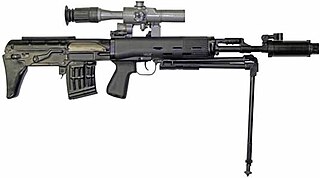
A bullpup firearm is one with its firing grip located in front of the breech of the weapon, instead of behind it. This creates a weapon with a shorter overall length for a given barrel length, and one that is often lighter, more compact, concealable and more maneuverable than a conventionally configured firearm. Where it is desirable for troops to be issued a more compact weapon, the use of a bullpup configuration allows for barrel length to be retained, thus preserving muzzle velocity, range and ballistic effectiveness.

The .50 Browning Machine Gun, also known as the .50 BMG, 12.7×99mm NATO, and designated as the 50 Browning by the C.I.P., is a .50 in (12.7 mm) caliber cartridge developed for the M2 Browning heavy machine gun in the late 1910s, entering official service in 1921. Under STANAG 4383, it is a standard service cartridge for NATO forces, as well as many non-NATO countries. The cartridge itself has been made in many variants: multiple generations of regular ball, tracer, armor-piercing (AP), incendiary, and saboted sub-caliber rounds. The rounds intended for machine guns are made into a continuous belt using metallic links.
The M14 rifle, officially the United States Rifle, Caliber 7.62 mm, M14, is an American selective-fire battle rifle chambered for the 7.62×51mm NATO cartridge. It became the standard-issue rifle for the U.S. military in 1957, replacing the M1 Garand rifle in service with the U.S. Army by 1958 and the U.S. Marine Corps by 1965. The M14 was used by the U.S. Army, Navy, and Marine Corps for Basic and Advanced Individual Training from the mid-1960s to the early 1970s.

An automatic rifle is a type of autoloading rifle that is capable of fully automatic fire. Automatic rifles are generally select-fire weapons capable of firing in semi-automatic and automatic firing modes. Automatic rifles are distinguished from semi-automatic rifles in their ability to fire more than one shot in succession once the trigger is pulled. Most automatic rifles are further subcategorized as battle rifles or assault rifles.

The IWI Tavor, previously designated as the Tavor TAR-21, is an Israeli bullpup assault rifle chambered in 5.56×45mm NATO calibre, designed and produced by Israel Weapon Industries (IWI). It is part of the Tavor family of rifles, which have spawned many derivatives of the original design.
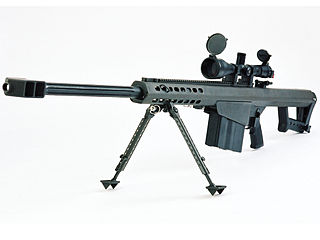
An anti-materiel rifle (AMR) is a rifle designed for use against military equipment, structures, and other hardware (materiel) targets. Anti-materiel rifles are chambered in significantly larger calibers than conventional rifles and are employed to eliminate equipment such as engines and unarmored or lightly armored targets. While modern armored vehicles are resistant to anti-materiel rifles, the extended range and penetration still has many modern applications. While not intended for use against human targets, the bullet weight and velocity of anti-materiel rifles gives them exceptional long-range capability even when compared with designated sniper rifles. Anti-materiel rifles are made in both bolt-action as well as semi-automatic designs.

The GP-25 Kostyor ("Bonfire"), GP-30 Obuvka ("Shoe") and GP-34 are a family of Russian 40 mm under-barrel muzzleloaded grenade launchers for the AK family of assault rifles. They were first seen by the West in 1984, during the Soviet Invasion of Afghanistan. The GP-30 was lightened and the redesigned sighting system was moved to the right.
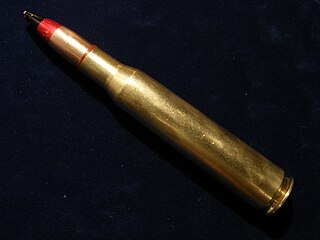
The 12.7×108mm cartridge is a 12.7 mm heavy machine gun and anti-materiel rifle cartridge used by the former Soviet Union and Warsaw Pact countries, including Russia, China, Iran, North Korea, and many others. It was invented in 1934 to create a cartridge like the German 13.2mm TuF anti-tank rifle round and the American .50 Browning Machine Gun round.

The Barrett M82 is a recoil-operated, semi-automatic anti-materiel rifle developed by the American company Barrett Firearms Manufacturing.

The Mk 14 Enhanced Battle Rifle (EBR) is an American military selective fire battle rifle, and a designated marksman rifle chambered for the 7.62×51mm NATO cartridge. It is a variant of the M14 battle rifle and was originally built for use with units of United States Special Operations Command, such as the United States Navy SEALs, Delta Force, and task specific Green Berets ODA teams/units.

A designated marksman rifle (DMR) is a modern scoped high-precision rifle used by infantry in the designated marksman (DM) role. It generally fills the engagement range gap between a service rifle and a dedicated sniper rifle, at around 300–600 metres (330–660 yd).

The Barrett M95 is a bolt-action rifle chambered in .50 BMG (12.7×99mm), and manufactured by Barrett Firearms Company. It has been adopted by a number of militaries around the world.
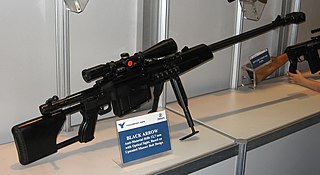
The M93 Black Arrow is a 12.7×108mm anti-materiel rifle developed and manufactured by Zastava Arms.

The VHS is a 5.56×45mm NATO bullpup assault rifle designed and manufactured by HS Produkt of Croatia. The VHS rifle was first introduced at the 2007 iKA exhibition, the annual Croatian innovation display that takes place in the city of Karlovac. The development began from a Croatian Army request for a new infantry rifle to meet NATO standards.
The Desert Tech Stealth Recon Scout (SRS) is a bolt-action sniper rifle developed by the Utah-based firearm manufacturer Desert Tech. It was unveiled at the 2008 SHOT Show. It is known for its bullpup design.

An assault rifle is a select fire rifle that uses an intermediate-rifle cartridge and a detachable box magazine. Assault rifles were first put into mass production and accepted into widespread service during World War II. The first assault rifle to see major usage was the German StG 44, a development of the earlier Mkb 42. While immediately after World War II, NATO countries were equipped with battle rifles, the development of the M16 rifle during the Vietnam War prompted the adoption of assault rifles by the rest of NATO. By the end of the 20th century, assault rifles had become the standard weapon in most of the world's armies, replacing full-powered rifles and submachine guns in most roles. The two most successful modern assault rifles are the AK-47 and the M16 designs and their derivatives.

The State Military Scientific-Technical Center "DELTA" is a legal entity of public law established by the decree of the President of Georgia. Its full name is Legal Entity of Public Law - State Military Scientific-Technical Center "DELTA". The scope of work of the organization is mainly focused on the Defense Industry and to some extent on the Civilian Field. The Center is an organization separate from state governing bodies. Its state control is exercised by the Ministry of Defense of Georgia The mission of the organization is based on the state interests of Georgia and the national defense strategy. The Center's primary responsibility is to encourage the growth of the domestic military industry. introduction of cutting-edge military technologies in the design, development, and mass production of combat gear and weapons that are in line with global trends. The only company in Georgia involved in the defense industry is State Military Scientific-Technical Center Delta. Today, “DELTA” has both intellectual and technical resources to design and manufacture both military and civilian products.
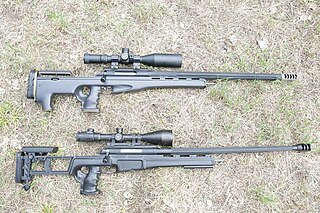
The SatevariMSWP is a proposed multi-caliber modular sniper rifle platform developed by STC Delta intended primarily for military but also limited civilian use. It was designed as convertible precision sniper rifle able to maintain high accuracy over long ranges and maximum effective ranges accordingly to cartridge and corresponding conversion.

















